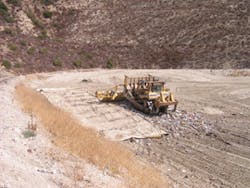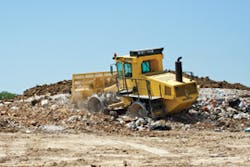Joe Minter knows how difficult it can be to find skilled dozer, loader and compactor operators, especially when you’re asking these operators to do their work at a landfill.
The work can be tedious. It requires long days spent cooped up in a cab. The work is often repetitious. And the smell? That’s not always pleasant.
The truth? Working in a landfill is rarely considered a dream assignment for machine operators. Many would prefer working construction sites or on road crews.
Minter should know: He’s the superintendent of the public works garage for the city of Rome in Georgia. Part of his job is making sure that the city has enough operators of heavy equipment-the dozers, loader, compactors, and material handlers-to push the city’s trash up the slopes of the Walker Mountain landfill and the five other county landfills that serve both the city of Rome and Floyd County.
There are times when this is far from an easy task. Minter relies on a crew of veterans to operate the heavy landfill equipment at the county’s landfills. But recruiting new talent to the landfills? That’s where the struggles begin, he says.
“It’s hard to find a good operator. It’s hard to find someone who will work in a landfill environment,” Minter says. “There are flies in the summer. It doesn’t smell good. And it’s cold in the winter. The guys we do have here have been here for years. The newer ones don’t tend to last too long. They tend to stick around until they find something better.”
And that’s unfortunate. The operators of the heaviest machines that work landfills-the dozers, compactors, and loaders-have important jobs.
Minter isn’t alone. Other superintendents across the country struggle to find the right personnel to operate the heavy machinery necessary to maintain landfills and haul municipal solid waste. And this is a trend that doesn’t look to change anytime soon. As Minter says, most operators of heavy machines don’t consider landfill work to be a plum assignment.
John Niswender, product consultant for four-wheel drive loaders and waste handlers with John Deere Construction Equipment, has seen the same trend.
“It is difficult for contractors to find operators for heavy landfill equipment. And it’s getting more difficult every day,” Niswender says. “Most people would rather sit at a desk than be in the field working heavy equipment. It’s cleaner behind a desk, and it doesn’t bounce you around as much.”
But job conditions aren’t the only reason why it’s challenging to find operators willing to work loaders and dozers at landfills. Younger workers have changed, too, Niswender says.
“Life has changed. Work ethics have changed,” he says. “Some kids want to come out at the top of the ladder. They don’t understand the mailroom concept of starting at the bottom and working to get to the top. Kids are also more computer-literate today than they are hands-on. That entices them go into other fields that they are more comfortable with.”
The good news? While it is more difficult to find operators for heavy landfill equipment, superintendents and municipalities at least don’t have to worry quite as much today about driver skill when looking for operators. That’s because today’s heavy equipment relies on new technology in order to be easier to direct and operate. Dozers, loaders, and compactors are also far more comfortable than they ever were.
Those operators, then, who are willing to work in a landfill can usually handle the dozers, compactors, and other landfill heavies after just a bit of training, something that can make finding these professionals at least a bit easier.
“You don’t really need a highly skilled operator today, because the machines are so easy to operate,” said Minter. “It’s not like the old days when you needed a feel for it. Now it’s like driving a new truck. There are some really nice tractors out there. You just have to get in the seat and move your hands around. It’s like playing a video game. We have often found good operators who before they came to us were operating lawn mowers.”
Ease of Use
Michael Stark, product specialist for wheel loaders for Doosan Infracore, says that technology has made controlling heavy landfill equipment easier than it’s ever been.
The reason? With tech, everything is now at the fingertips of operators.
“Monitoring. The controls. Different power modes. Everything is there for the operators,” Stark says. “You can change your power mode with the flip of a switch.
A John Deere 850 covers trash with dirt.
You can move to economy mode, where you don’t need as much power, with the flip of a switch, too. There are LCD displays. There is so much information there for the operators of wheel loaders and excavators. It makes it much easier to operate the vehicles more efficiently and safely.”
Brian Bereika, product specialist at Doosan for articulated dump trucks and wheeled excavator products, says that improved technology makes operating heavy landfill equipment safer, too.
“Articulated dump trucks are some of the heaviest pieces of equipment in a landfill. They can go 30 miles an hour. They are subject to centrifugal force,” he says. “Any information that the operator can get in the cab to minimize any accidents is welcome. And today they have plenty of technology to help them understand when a machine is stable and not stable. There have been a lot of changes in that regard.”
But even with this technology, Bereika says, it takes skilled operators to handle such vehicles as articulated dump trucks.
Unfortunately, too many contractors still believe that anyone can jump into a cab and successfully maneuver these large vehicles around landfill sites, he says.
“Who is the operator of the day? That’s too often how companies approach it,” Bereika says. “It is true that trucks have gotten simpler. It’s easier to get into the cab and make the wheels turn and do the minimal work required. Practically anyone can do that. But if you want better performance it does take training and knowledge to be safe and productive. The danger comes when people think anyone can do this job. They can’t. It takes training.”
Ease of use is good news for harried public works superintendents across the country. Municipalities today are still struggling with slashed budgets. It helps, then, when municipalities can quickly hire operators to drive their heavy landfill equipment without first having to spend an inordinate amount of time and money training them.
And because today’s machines are easier to operate and include improved safety features, municipalities aren’t putting anyone at risk when their operator-training sessions are condensed. They’re also not receiving substandard work at their landfill sites for the same reasons.
“They’ve taken so much of the knowledge out of that type of job with the modern machines,” Minter says. “That makes it a lot easier for us to hire somebody. It doesn’t take the skill level to operate these machines as it used to.”
Dave Dennison, manager of marketing services and product manager for Bomag/Compaction America, agrees with Minter that today’s advanced machinery makes it easier for operators to master the heavy equipment needed at landfills.
His company’s compactors are a good example. They feature an easy-to-use joystick that allows operators to move the vehicles’ blades intuitively. After some basic training with the controls most operators, especially if they’ve had some experience operating heavy machinery or even midsize machines, can master the vehicles, Dennison says.
At the same time, the machines that Bomag and other manufacturers sell are more comfortable, making the job of operating heavy landfill machinery less stressful on the bodies of operators.
This combination should make it easier for municipalities to find operators qualified to operate these machines, Dennison said.
“I don’t think it’s too hard to find good operators today,” he says. “The landfill machines we build are relatively easy to operate. It’s not that you don’t need any skills to operate them. But they are designed so that operators can learn what they need to quickly, so that they can master the machines’ operations faster than in the past.”
Increased Comfort
Comfort is a big reason for the quick learning curve associated with today’s heavier landfill vehicles, according to Dennison. Cabs are more spacious than they once were. And seats offer more comfort thanks to multiple-position arm rests and head rests that better fit operators of differing sizes.
These might seem like minor advancements, but they do make a difference during a long day at a landfill. Operators, after all, tend to spend long hours in their cabs. Anything that can make those hours more comfortable is appreciated.
A tighter, more cramped cabin that doesn’t allow for adjustments according to operator body type can make for a long, uncomfortable day for operators. And when operators are uncomfortable, they’re more likely to make mistakes.
“The general environment for the operator is so much better today than it was five or 10 years ago,” Dennison said. “Remember, operators are in their cabins sometimes 10 or more hours a day. Today’s cabins are extremely comfortable. That is a very significant improvement or change to these machines. The comfort of the operator has become a big concern. They can sit in those cabs for multiple hours and not feel too much discomfort.”
Today’s cabs are also quieter than were earlier versions. Again, this makes a bigger impact than most people think. Spending an entire 10-hour day listening to uncomfortably high levels of noise can throw even the most experienced and skilled contractors off their games and cause them to make mistakes.
“We are continually striving to reduce the noise levels inside a cab to as low a volume as possible,” Dennison says. “That’s an important mission for us. Just like we don’t want the end users of our machines to be uncomfortable inside our cabins, we don’t want operators subjected to uncomfortable noise levels all day, either. That makes a difference in the comfort and performance of operators.”
The good news, for operators and for landfill supervisors, is that manufacturers are continually refining their equipment. This means that dozers, compactors, loaders and material haulers will become even easier to use in the coming years.
A Caterpillar dozer spreads ADC tarp.
And this could make it easier for landfill operators and supervisors to find the vehicle drivers that they need to contend with the ever-growing wastestreams hitting their sites.
“There are always improvements and advancements to be made,” Dennison said. “This is an industry that does evolve over time. It is not a static industry that is afraid of change.”
Skills Still Needed
It’s important to note, though, that even though machines are getting easier to operate, skilled operators are still in demand at landfills across the country. Technology and comfort levels are rising in compactors, dozers, and loaders. But all this tech and comfort won’t have much impact if the drivers of these machines don’t care enough about their jobs to improve their craft. Operating a dozer or loader requires both skill and patience. And these are the two traits that the best operators possess and can often be the most difficult to find.
“Meticulous. Painstakingly so.” That’s the quality that Dennison says the best heavy equipment operators have.
“You need someone who can react to unexpected situations and be able to make quick decisions,” Dennison says. “You need somebody who has confidence. These operators have to do multiple things throughout the day. They often have multiple operations running at the same time.”
Bruce Boebel, senior product manager for tracked products with Komatsu America Corp., says that the operators of dozers and loaders can be easily distracted. Landfills are busy places. The operators of heavy machinery need to be aware of where other vehicles and workers are at all times.
And that’s just one skill set. Operators need to know about their landfill’s specific waste flow, too, Boebel says. Every landfill has a unique layout and topography. The best operators understand how trash flows at their job site and which traffic paths of garbage trucks to avoid. They also learn the busy times when they need to work faster to keep up with the inflow of trucks.
And when they understand this, they can adjust their work schedules accordingly to make sure that they don’t fall behind or create backups or bottlenecks at the landfills.
“Operators need to be alert,” Boebel says. “They must always be aware of their surroundings. There are a lot of machines running at any one time in a landfill. For example, the main dozer may need to be aware of where the compactor and another dozer are spreading cover. The skilled operators are always aware of where these other machines are. They are always adjusting to where everyone is.”
Operators must know their machines, too. And this is where new technology and comfort features come in. Today’s dozers, loaders, and compactors come with functions designed to make operating this equipment easier.
But if operators don’t understand how these tools work, they can’t take advantage of them. And that can result in a less efficient use of the heaviest vehicles that work at a landfill.
“It’s very important that operators understand the machine they operate,” Boebel says. “That way they can use its features to their full advantage.”
Niswender from John Deere says that operators need good hand-eye coordination and depth perception. He also says that “time in the saddle”-also known as experience-plays a role, too.
“As in any role, there are some naturals, some that can improve through practice and experience, and others who just don’t have what it takes to be a good operator,” Niswender says.
Even some of the most skilled operators of heavy equipment struggle to succeed in a landfill environment, Niswender says.
A John Deere wheel loader shores
up a newly arrived load of waste.
That’s because landfill work comes with different challenges. Some operators, for instance, can never get used to the smell. That sounds like a minor challenge, but operators are working with the smell of garbage all day long. For some, it’s not an easy hurdle to overcome.
“Some dirt jockeys come in who are top-notch operators. But they just can’t get into landfill mode,” Niswender says. “It takes a different approach in handling the material. There is the smell. Working with garbage is not the same as excelling at a dirt job.”
New tech, though, has made operating in a landfill easier than it was when Niswender first got his start in the industry back in 1984.
And what tech and new features do today’s landfill heavies boast? Boebel points to his company’s D155AX-7 model of waste handler dozers. This model features an auto-shift mode that operators can set with default speed settings so that the machine will downshift and upshift transmission speeds automatically based on blade load. This feature can greatly reduce the fatigue that operators experience during long days in their landfills. It can also improve cycle times.
“If a machine has features like that, it is definitely an advantage for the operator,” Boebel says. “The key, though, is for operators to actually know their machines and understand their features. Taking advantage of all the features that machines offer can make for a more comfortable and efficient day of work.”
Komatsu’s D65-17 and D155AX-7 waste handler dozers also offer standard rear view cameras. These, of course, can boost operator awareness at a landfill. Operators can also set the cameras so that they “synchronize” with the dozer’s reverse operation, further enhancing both awareness and efficiency at the job site.
“There are mirrors on most landfill machines. Operators should use them to increase their awareness level and to help look out for others,” Boebel says. “If you have access to a rear view camera, that is another feature to help you be more aware of your surroundings. That’s another convenient feature that will help operators.”
Then there are the auto-reversing fans that many landfill machines today boast. These fans allow machines to operate longer between periodic maintenance because the auto-reverse feature helps to keep dirt, dust, and other debris from clogging the cooling system.
Again, though, operators should be aware of conditions at their landfill, making sure to set auto-reverse fans at the proper interval for their machines given their unique environmental conditions.
John Deere landfill machines are outfitted with sensors that allow operators to monitor their vehicle’s temperature, tire pressure, switch continuity, fault codes, and more. Supervisors can even rely on telematics to remotely monitor the performance of their operators.
As Niswender says, supervisors can monitor the amount of fuel operators are burning and how much time they spend in one gear. They can then make changes to the operator’s performance depending on this data.
Upgrades
The best news for landfill supervisors and the operators of their heavy machines is that the pace of technology and comfort upgrades to dozers, compactors, loaders, and other heavy landfill equipment isn’t about to slow.
Boebel, like Dennison, points to the latest comfort features of these machines as an example. For instance, Komatsu’s D155AX-7 dozers are extremely quiet machines, he says. The noise levels are far lower than they were just five or 10 years earlier.
“We have such a quiet cab. An operator can have a cell phone on and carry on a conversation while the machine is parked and running,” Boebel said. “They are much quieter than they were in the past.”
The machines operate more efficiently and are easier on the environment, too. As Boebel says, the days of thick black smoke pumping from landfill machines’ exhaust pipes is long gone with the introduction of EPA Tier 4 emissions-certified models.
Inside their cabs, many of the latest landfill machines offer heated or air-suspended seats to boost the comfort levels of operators. It’s also easier today for operators to see larger swaths of landfill from inside their cabs. And, in a move that landfill operators across the country appreciate, today’s dozers, loaders, and compactors consume less fuel during an average day of work, something that can save municipalities significant money over time.
All of this makes operating these heavy machines a less taxing job than it once was, Boebel says.
But like representatives with other manufacturers, Boebel does recommend that municipal landfill officials spend the right amount of time training both new and experienced operators on how to run their heavy machines effectively.
Yes, technology and comfort features have created an entire class of dozers, loaders, and other machines that are easier to operate. But these machines can still cause problems if their operators aren’t trained properly.
Boebel said that landfill operators can improve the training that their machine operators receive by making adequate instruction something that machine distributors need to provide if they expect to sell their dozers, compactors and loaders to them.
“Most of these landfill facilities put out bids for equipment. As part of that bid, they should request onsite training by the distributor or dealer to help operators get up to speed and be more efficient from the start,” Boebel says. “Good training upfront from the experts is very beneficial.”
It’s important, too, that operators study the operation and maintenance manuals that come with new machines. These manuals spell out the features and benefits of landfill machines. Studying the manuals might be dry work, but by doing so operators will boost their chances of mastering there new machines as quickly as possible.
“Time spent with the O&M manual is time well spent for operators,” Boebel says.
While it’s true that heavy landfill machines today rely on often complex technology, that’s not something that their operators usually have to worry about. When something does go wrong with a tech-powered dozer or loader? The machine’s onboard diagnostics typically tell operators and landfill managers exactly what’s wrong and what needs to be done to correct the problem.
Pride Matters
Working in a landfill might not count as glamorous work. However, there is a benefit to working a dozer, compactor or loader in such an environment: Sitting behind the controls of such large vehicles can actually be fun.
A heavy compactor negotiates the contours
Just ask Boebel. “Some of these pieces of equipment are as big as small house,” he says. “It can be fun to get out there and use a machine with that much power and force at a landfill. It can be a lot of fun and fulfilling.”
And not only is it fun, operating such a powerful machine can also generate a sense of pride, Boebel says.
Boebel says he’s seen operators who keep a stash of cleaning supplies in their cabs so that they can keep the exteriors and interiors of their machines looking their best at all times. Others never have a dirty cab, while others scrub their machines down on a daily basis.
“Operators take pride in being able to operate the large equipment,” Boebel says. “A lot of the operators take a lot of pride in their machines. They keep them clean. They keep them scrubbed out. These machines are, after all, kind of like their mobile offices.”
John Deere’s Niswender has experience with heavy landfill equipment. When he got his start in the industry, he actually operated these machines before moving into management.
The way he sees it, there’s a certain art to operating heavy landfill equipment.
“You can take a pile of land and sculpt it to completely change how it looks, how water flows through it,” Niswender says. “That is gratifying. Then there’s the stress-management aspect of it. It fulfills an individual’s need to destroy something from time to time. Not only do you get to run over and crush things, but you get paid to do it.”






